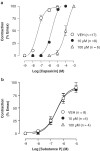Halogenation of a capsaicin analogue leads to novel vanilloid TRPV1 receptor antagonists
- PMID: 12922928
- PMCID: PMC1573981
- DOI: 10.1038/sj.bjp.0705387
Halogenation of a capsaicin analogue leads to novel vanilloid TRPV1 receptor antagonists
Erratum in
- Br J Pharmacol. 2003 Nov;140(5):1008
Abstract
1. The C-5 halogenation of the vanillyl moiety of resiniferatoxin, an ultrapotent agonist of vanilloid TRPV1 receptors, results in a potent antagonist for these receptors. Here, we have synthesized a series of halogenated derivatives of 'synthetic capsaicin' (nonanoyl vanillamide=nordihydrocapsaicin) differing for the nature (iodine, bromine-chlorine) and the regiochemistry (C-5, C-6) of the halogenation. 2. The activity of these compounds was investigated on recombinant human TRPV1 receptors overexpressed in HEK-293 cells. None of the six compounds exerted any significant agonist activity, as assessed by measuring their effect on TRPV1-mediated calcium mobilization. Instead, all compounds antagonized, to various extents, the effect of capsaicin in this assay. 3. All 6-halo-nordihydrocapsaicins behaved as competitive antagonists against human TRPV1 according to the corresponding Schild's plots, and were more potent than the corresponding 5-halogenated analogues. The iodo-derivatives were more potent than the bromo- and chloro-derivatives. 4. Using human recombinant TRPV1, 6-iodo-nordihydrocapsaicin (IC(50)=10 nM against 100 nM capsaicin) was about four times more potent than the prototypical TRPV1 antagonist, capsazepine, and was tested against capsaicin also on native TRPV1 in: (i) rat dorsal root ganglion neurons in culture; (ii) guinea-pig urinary bladder; and (iii) guinea-pig bronchi. In all cases, except for the guinea-pig bronchi, the compound was significantly more potent than capsazepine as a TRPV1 antagonist. 5. In conclusion, 6-iodo-nordihydrocapsaicin, a stable and easily prepared compound, is a potent TRPV1 antagonist and a convenient replacement for capsazepine in most of the in vitro preparations currently used to assess the activity of putative vanilloid receptor agonists.
Figures






Similar articles
-
Neurogenic responses mediated by vanilloid receptor-1 (TRPV1) are blocked by the high affinity antagonist, iodo-resiniferatoxin.Br J Pharmacol. 2003 Mar;138(5):977-85. doi: 10.1038/sj.bjp.0705110. Br J Pharmacol. 2003. PMID: 12642400 Free PMC article.
-
Characterization of A-425619 at native TRPV1 receptors: a comparison between dorsal root ganglia and trigeminal ganglia.Eur J Pharmacol. 2008 Oct 31;596(1-3):62-9. doi: 10.1016/j.ejphar.2008.07.063. Epub 2008 Aug 5. Eur J Pharmacol. 2008. PMID: 18755179
-
Competitive inhibition by capsazepine of [3H]resiniferatoxin binding to central (spinal cord and dorsal root ganglia) and peripheral (urinary bladder and airways) vanilloid (capsaicin) receptors in the rat.J Pharmacol Exp Ther. 1993 Nov;267(2):728-33. J Pharmacol Exp Ther. 1993. PMID: 8246148
-
The vanilloid (capsaicin) receptor: receptor types and species differences.Gen Pharmacol. 1994 Mar;25(2):223-43. doi: 10.1016/0306-3623(94)90049-3. Gen Pharmacol. 1994. PMID: 8026721 Review.
-
Recent developments in transient receptor potential vanilloid receptor 1 agonist-based therapies.Expert Opin Investig Drugs. 2004 Nov;13(11):1445-56. doi: 10.1517/13543784.13.11.1445. Expert Opin Investig Drugs. 2004. PMID: 15500392 Review.
Cited by
-
Rational design and validation of a vanilloid-sensitive TRPV2 ion channel.Proc Natl Acad Sci U S A. 2016 Jun 28;113(26):E3657-66. doi: 10.1073/pnas.1604180113. Epub 2016 Jun 13. Proc Natl Acad Sci U S A. 2016. PMID: 27298359 Free PMC article.
-
Phytochemicals for the Management of Melanoma.Mini Rev Med Chem. 2016;16(12):953-79. doi: 10.2174/1389557516666160211120157. Mini Rev Med Chem. 2016. PMID: 26864554 Free PMC article. Review.
-
Synthesis and biological evaluation of [¹¹C]SB366791: a new PET-radioligand for in vivo imaging of the TRPV1 receptor.Nucl Med Biol. 2013 Jan;40(1):141-7. doi: 10.1016/j.nucmedbio.2012.08.011. Epub 2012 Nov 7. Nucl Med Biol. 2013. PMID: 23141549 Free PMC article.
-
Medial prefrontal cortex TRPV1 channels modulate the baroreflex cardiac activity in rats.Br J Pharmacol. 2015 Nov;172(22):5377-89. doi: 10.1111/bph.13327. Epub 2015 Nov 4. Br J Pharmacol. 2015. PMID: 26360139 Free PMC article.
-
Physiology and pharmacology of the vanilloid receptor.Curr Neuropharmacol. 2006 Jan;4(1):1-15. doi: 10.2174/157015906775202995. Curr Neuropharmacol. 2006. PMID: 18615132 Free PMC article.
References
-
- BIRDER L.A., NAKAMURA Y., KISS S., NEALEN M.L., BARRICK S., KANAI A.J., WANG E., RUIZ G., DE GROAT W.C., APODACA G., WATKINS S., CATERINA M.J. Altered urinary bladder function in mice lacking the vanilloid receptor TRPV1. Nat. Neurosci. 2002;5:856–860. - PubMed
-
- CATERINA M.J., LEFFLER A., MALMBERG A.B., MARTIN W.J., TRAFTON J., PETERSEN-ZEITZ K.R., KOLTZENBURG M., BASBAUM A.I., JULIUS D. Impaired nociception and pain sensation in mice lacking the capsaicin receptor. Science. 2000;288:306–313. - PubMed
-
- CHUNG K.F., CHANG A.B. Therapy for cough: active agents. Pulm. Pharmacol. Ther. 2002;15:335–338. - PubMed
-
- DAVIS J.B., GRAY J., GUNTHORPE M.J., HATCHER J.P., DAVEY P.T., OVEREND P., HARRIES M.H., LATCHAM J., CLAPHAM C., ATKINSON K., HUGHES S.A., RANCE K., GRAU E., HARPER A.J., PUGH P.L., ROGERS D.C., BINGHAM S., RANDALL A., SHEARDOWN S.A. Vanilloid receptor-1 is essential for inflammatory thermal hyperalgesia. Nature. 2000;405:183–187. - PubMed
Publication types
MeSH terms
Substances
LinkOut - more resources
Full Text Sources
Other Literature Sources
Miscellaneous

